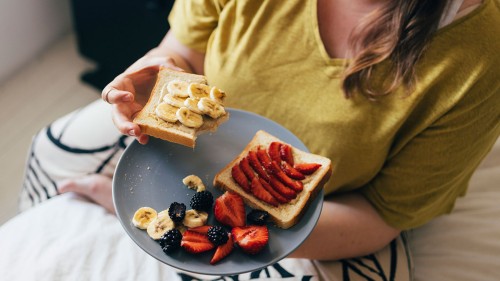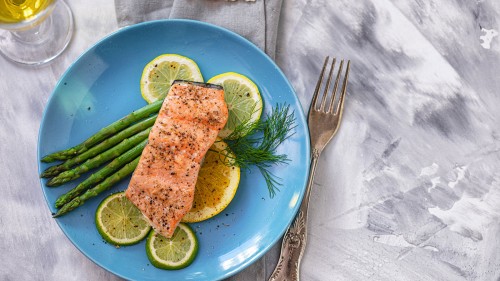How to Break a Weight-Loss Plateau: 12 Tips That Actually Work
Published on January 6, 2022
Medically Reviewed by Ana Reisdorf, MS, RD
A weight-loss plateau is when you temporarily stop losing weight. This can be incredibly frustrating, but there are steps you can take to get the scale moving again.


The process of losing weight is a journey, to say the least. It usually starts out great, where you may be seeing results, losing weight consistently, and are feeling super motivated.
It is new, exciting, and it’s working. This is common in the first few weeks to months of the weight-loss process.
But at some point in the process, the weight loss stalls, and you hit a weight-loss wall. This happens to everyone and is called a weight-loss plateau, or diet plateau.
When this happens, you may stop losing weight completely, with no apparent rhyme or reason as to why. This may occur even when you feel you are still doing all the right things with your diet and exercise habits, which can lead you to feel defeated.
It’s important to remember that weight-loss plateaus happen to everyone at some point in their weight loss journey — sometimes more than once.
It is a normal part of the process and not something to beat yourself up about. And the good news is that there are things you can do to beat a weight-loss plateau.
What Causes Weight-Loss Plateaus?
As you lose weight, your calorie needs naturally start to decrease and your metabolism begins to slow down.
Weight-loss plateaus happen when your body starts to adapt to your lower weight and metabolic rate. And when your metabolic rate decreases, you burn fewer calories both at rest and during your workouts.
In order to continue losing weight, you may have to either reduce your calories, increase your metabolic rate, or both.
Will a Weight-Loss Plateau Go Away on Its Own?
While weight-loss plateaus can be temporary, they typically won’t just go away on their own if you don’t change anything.
You may only see weight loss start up again if you lost your initial water weight at the beginning of your journey and temporarily hit a wall.
This is common in the first few weeks of weight loss, where it should then start up again in a more gradual way.
In general, after each weight-loss plateau you hit, diet, exercise, and lifestyle factors will need to be reevaluated. Habits may need to be changed in order to break through a plateau.
You don’t have to change everything at once; in fact, we recommend changing one habit at a time so that you can see what is truly working to kickstart your weight loss again.
Here are 12 tips on what to do when you hit a weight-loss plateau so you can start seeing results again.
1. Start Tracking Your Food Intake
Research shows that many people vastly underestimate their calorie intake. And if you’re not tracking your food intake, it’s easy to do this. (1)
The reality is that if you’re not tracking, it’s hard to know if you’re truly eating in the same way as you were when you were actively losing weight.
Studies have shown that just the act of food tracking itself may increase weight loss. (2)
Logging your food helps you become more aware of what and how much you’re eating. This can help you identify anything preventing you from losing weight.
For example, maybe your portions have crept up, you started getting more relaxed with snacks or wine, or you are not drinking as much water as you used to.
Tracking also helps with accountability. Knowing that you have to track can make you put more conscious thought into your food choices to move past a diet plateau.
2. Increase Protein
Protein is essential for weight loss for several reasons.
Out of all the three macronutrients (carbs, protein, and fat), protein is by far the best for your metabolism. When you consume high-protein foods, your body burns 20%–30% more calories on average than from eating fat and carbs.
This calorie burn is known as the thermic effect of food (TEF), and a higher TEF helps increase your metabolism. (3)
Including more protein in the diet also helps to maintain lean muscle mass.
Essentially the more lean muscle you have, the faster your metabolic rate is. This is a good thing, as a faster metabolic rate helps you burn more calories by simply doing nothing!
Protein is also super filling, so having protein with every meal helps curb cravings. If you don’t feel full or satisfied after meals, or you’re finding yourself constantly hungry, you may not be getting enough protein in your diet.
Good protein sources include lean chicken, fish, turkey, tofu, eggs, Greek yogurt, cottage cheese, beans, lentils, nuts, and seeds.
For best results, it’s recommended to eat at least 20–30 grams of protein per meal, depending on the person.
3. Manage Stress
Stress can have a significant impact on your ability to lose weight. I’ve seen it with several of my clients who are super stressed. They are doing all the right things, but they can’t seem to overcome a weight-loss plateau.
When you’re stressed, your body produces more of a hormone called cortisol. This is known as the stress hormone. If you’re experiencing chronic stress and your cortisol levels remain elevated, it can make it difficult to lose weight. (4)
Cortisol particularly loves to hold on to weight in the belly area, one of the most challenging areas to lose fat.
Stress can also lead to mindless eating, overeating, and cravings for comfort foods. Increased stress can often be a reason why weight loss stops.
While you can’t remove all the stress in life, you can control how you manage it. Practicing stress-relieving techniques such as deep breathing, meditation, yoga, or journaling can help keep stress levels at bay.
There are even natural supplements thought to help reduce stress levels.
If these stress-reducing techniques are not enough, seek the help of a licensed therapist who can provide individualized guidance.
4. Up Your Workout Routine
If you’ve been doing the same workouts for months, it may be time to change things up. Even if you’re working out consistently, your body adjusts to doing the same type of workout routine.
Just like it adjusts to a new weight, it adjusts to your workouts and will stop giving you results unless you kick it up a notch.
To up your routine, try increasing the frequency, duration, or intensity of your workouts. This could mean tacking on an extra 10 minutes to your cardio workouts, working out five times a week instead of three, or lifting heavier weights during your strength training sessions.
Your body adapts very quickly to what you’re doing, and in order to continue to see fat loss and muscle gain, it needs to be constantly challenged.
This can also help break up the monotony in your workouts and make them more exciting!
5. Get Enough Sleep
If your sleep habits have changed or you lack sleep, it can make it harder to lose weight. When you lack sleep, chances are you feel fatigued and less motivated to eat well.
Poor sleep also affects the levels of several hormones involved in metabolism and appetite, such as cortisol, ghrelin, and leptin. When these hormones become out of whack, they can lead to powerful food cravings that are difficult to ignore.
Improving your sleep quality is one habit that can help you beat a plateau. Aim for 7–8 hours of sleep per night.
To get more quality Zzzs, create a relaxing bedtime routine for yourself. This may mean shutting off all electronics within 30 minutes of bedtime, meditating, taking a warm bath, or reading a book.
6. Try Intermittent Fasting
Intermittent fasting has gained popularity over the past several years as a weight-loss method. It has been shown to promote both weight loss and fat loss without decreasing muscle mass. (5)
The good thing about intermittent fasting is you don’t have to change what you’re eating, but only the timing of when you eat.
I have had clients that saw additional weight loss after starting intermittent fasting, even without making any significant changes to their diet.
There are many versions of intermittent fasting, but the most popular method is the time-restricted eating method.
With this method, you fast for a certain number of hours, typically at least 12–16 hours, and then have an “eating window” of 8–12 hours.
I’ve seen intermittent fasting to be the most beneficial for people who graze often and lack structure in their eating schedule. Setting a strict time window for eating helps create more of a meal structure and prevents snacking and late-night eating.
If you have diabetes or take medications that require food at certain times, intermittent fasting may not be for you.
7. Drink More Water
Drinking more water may help reverse a plateau in weight loss. Increasing your water can boost metabolism, improve digestion, and help reduce your overall calorie intake.
A 12-week study showed those who drank a cup of water before meals lost 44% more weight than the placebo group. (6)
This is an impressive result and is likely due to water’s ability to fill us up, reducing food intake at that subsequent meal.
Water also provides needed energy for more effective workouts, helping you produce a greater calorie burn.
Additionally, when you may think you’re hungry, you could actually be thirsty. The physical feeling that comes with being hungry or thirsty is similar, so it’s easy to get them confused.
The next time you think you may be hungry, think back to the last time you ate. If it was recently, try drinking water first to see if it was just your thirst that needed quenching.
8. Add More Fiber
If you’ve hit a wall in weight loss, try incorporating more fiber into your diet.
Fiber enhances satiety, which can help reduce your calorie intake. It also helps slow down digestion, providing longer-lasting fullness, and in turn, reducing hunger and curbing cravings between meals.
And what’s even better is many foods naturally high in fiber are also low in calories.
To increase your fiber intake, add at least one fruit or vegetable with each meal or snack, and incorporate more whole grains such as quinoa, brown rice, and oats with your meals.
9. Limit Alcohol
Alcohol intake can cause stagnant weight loss. While it may not need to be avoided entirely, it should be limited as much as possible.
An occasional glass of wine is fine, but drinking alcohol regularly can impede your ability to lose weight. Alcohol is high in calories and lowers your inhibitions, leading to more negative and impulsive food choices.
Alcohol also tends to go straight to our gut, making it especially hard to lose weight around the abdominal area. It can also cause dehydration and headaches, and affect your sleep. (7)
All of these things can affect your energy level and motivation to maintain healthy habits, and bring you down.
If you choose to drink alcohol, stick to one serving (5 ounces of wine, 1.5 ounces of hard liquor, or 12 ounces of beer). (8)
10. Increase Daily Movement (NEAT)
If you’re penciling in 30 minutes of exercise a day but are completely sedentary the rest of the day, you are missing out on many calorie-burning opportunities.
This is because it’s not just scheduled exercise that assists in weight loss – your daily movement counts too.
Research shows increasing your non-exercise activity thermogenesis (NEAT) can also increase your metabolic rate and burn calories. (9)
What counts as NEAT activity? Essentially anything that involves moving! Standing instead of sitting while working, increasing your daily step count, or taking the stairs all count towards your daily calorie burn.
Make it a point to get in more movement throughout the day, and take frequent opportunities to do stretches, squats, or jumping jacks to get your heart rate up. If you have a fitness tracker, a good goal to aim for is 10,000 steps each day.
All of these activities count towards your daily calorie burn and can serve as plateau breakers.
11. Consult a Registered Dietitian
If you feel like you’ve tried everything and can’t figure out how to jumpstart weight loss again, consider seeking the guidance of a registered dietitian.
A registered dietitian can help you identify the barriers that may have caused you to stop losing weight and provide personalized advice on how to get out of a weight-loss plateau.
Working with a dietitian and coach also helps to provide accountability, which can motivate you to continue practicing healthy habits even on the tough days.
Because when it comes down to it, even if you’re not losing right now, there are always other positive changes you may be seeing in yourself that are separate from your weight.
12. Focus on Non-Scale Victories
Even if you have a goal to lose weight, that doesn’t mean that is the only result you should measure.
Sometimes, putting all your focus into that number on the scale can lead you to feel pressured and defeated when it’s not the number you want to see.
Paying attention to the non-scale victories that are also happening can keep you motivated and remind you that you’re still seeing results.
Some examples of non-scale victories you may see in yourself include:
- Body composition changes such as fat loss or muscle gains
- Clothes fitting better
- More energy or confidence
- Improved health markers such as cholesterol or blood pressure numbers
- A healthier relationship with food
- Reduced cravings
- Better mood
- Improved sleep
Make a list of all of your non-scale victories and post it somewhere where you’ll see it regularly. This will serve as a regular reminder of all the good happening in your weight-loss journey.
Reassess Your Weight-Loss Goals Regularly
If you’ve tried all of these tactics and are still in a weight-loss plateau, you may consider reassessing your overall goals. When it feels that difficult to lose weight, it may be because you are already at the best weight for you.
Your healthiest weight is not always necessarily your lowest weight. Rather, it is the weight that you feel your best and can maintain without restriction.
If you have to be super strict in order to get to that “perfect” weight, maybe that weight is not the best for you.
Sometimes, it may take a bit of trial and error to determine what your perfect weight is, but once you do, it’s just a matter of continuing doing what you’re doing to stay there.
Frequently Asked Questions
What is a weight-loss plateau?
A weight-loss plateau is when your weight loss stalls in your weight-loss journey. This can happen at any time of the weight-loss process but tends to happen as you get closer to your goal weight.
What causes a weight-loss plateau?
Weight-loss plateaus occur as your body adapts to your new weight and habits.
As you lose weight, your calorie requirements and metabolism slow down, requiring you to either decrease your calorie intake further or increase your calorie burn in order to continue losing weight.
Are weight-loss plateaus normal?
Yes, weight-loss plateaus are completely normal! Unfortunately, they are part of the process and are simply the nature of how our bodies adjust to a changing metabolism. But, there are things you can do to break a plateau.
How long do weight-loss plateaus last?
Weight-loss plateaus typically last 1–3 months, depending on how quickly you’re implementing changes to get the scale moving along again.
How can I overcome a weight-loss plateau?
The first step is re-evaluating your habits, then making any necessary changes to your diet and exercise routine. Managing stress, limiting alcohol, and getting in quality sleep are also all important factors in overcoming a weight-loss plateau.
The Bottom Line
Weight-loss plateaus can be incredibly frustrating, but they are a normal part of the weight-loss process.
Fortunately, there are several steps you can take to kick-start weight loss again and gain momentum back.
By implementing these strategies to break through a weight-loss plateau, you’ll be able to determine what is working best for you so you can keep doing it.
At WellnessVerge, we only use reputable sources, including peer-reviewed medical journals and well-respected academic institutions.
- Consumers' estimation of calorie content at fast food restaurants: cross sectional observational study:
https://pubmed.ncbi.nlm.nih.gov/23704170/ - Weight loss during the intensive intervention phase of the weight-loss maintenance trial:
https://pubmed.ncbi.nlm.nih.gov/18617080/ - Diet induced thermogenesis:
https://www.ncbi.nlm.nih.gov/pmc/articles/PMC524030/ - Effect of increase in cortisol level due to stress in healthy young individuals on dynamic and static balance scores:
https://www.ncbi.nlm.nih.gov/pmc/articles/PMC6371989/ - Intermittent fasting and weight loss:
https://www.ncbi.nlm.nih.gov/pmc/articles/PMC7021351/ - Water consumption increases weight loss during a hypocaloric diet intervention in middle-aged and older adults:
https://pubmed.ncbi.nlm.nih.gov/19661958/ - Alcohol Consumption and Obesity: An Update:
https://www.ncbi.nlm.nih.gov/pmc/articles/PMC4338356/ - What Is A Standard Drink?:
https://www.niaaa.nih.gov/alcohols-effects-health/overview-alcohol-consumption/what-standard-drink - The Role of Non-exercise Activity Thermogenesis in Human Obesity:
https://www.ncbi.nlm.nih.gov/books/NBK279077/






